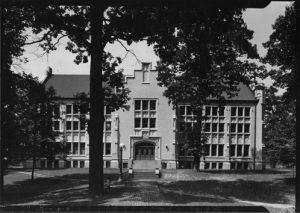“Exercise thyself unto godliness: for bodily exercise is profitable for a little; but godliness is profitable for all things, having promise of the life which now is, and of that which is to come,” – Bible verse on the dedicatory plaque of Severance Gymnasium, 1912
Dedicated in 1912, Severance Gymnasium was the first academic building constructed outside of the Quinby quadrangle. Built behind Kauke, Severance was the gift of Wooster’s most prolific benefactor, Louis H. Severance.
A prosperous Cleveland robber baron and captain of industry, Louis H. Severance first became associated with the Presbyterian Church through his mother, who was a devout Christian. After his retirement from Standard Oil, where he had worked as the treasurer, Severance dedicated himself to charitable and missionary causes through the Presbyterian Church.1 Severance came to explore the University of Wooster at the request of President Holden, who urged him to take an interest in the institution run by the Synod of the Presbyterian Church. Severance immediately took notice of the fledgling academy, and when he heard of the Old Main fire, Severance sent a telegram to Holden, which read, “Don’t worry. Perhaps [it is] the best thing that could happen to Wooster. When you have formulated a plan come and see me.”2
 The Old Main fire became the catalyst behind Severance’s patronage of the University. For the next 15 years until his death, Severance and Holden cultivated an extremely personal and profitable business relationship. Holden described their relationship in his autobigography, mentioning that they were like father and son. 3 Immediately elected to the Board of Trustees after his initial donation to build Severance Chemistry after the Old Main fire, Louis Severance was named the chair of the Trustees in 1905. Together Severance and Holden shaped the college in Christian educational ideals, presiding over the rebirth and continued growth of the institution. The crowning gift of Louis Severance’s later life dedication to Wooster was Severance Gymnasium and the accompanying athletic fields.
The Old Main fire became the catalyst behind Severance’s patronage of the University. For the next 15 years until his death, Severance and Holden cultivated an extremely personal and profitable business relationship. Holden described their relationship in his autobigography, mentioning that they were like father and son. 3 Immediately elected to the Board of Trustees after his initial donation to build Severance Chemistry after the Old Main fire, Louis Severance was named the chair of the Trustees in 1905. Together Severance and Holden shaped the college in Christian educational ideals, presiding over the rebirth and continued growth of the institution. The crowning gift of Louis Severance’s later life dedication to Wooster was Severance Gymnasium and the accompanying athletic fields.
Severance Gymnasium is the culmination of Holden’s and Severance’s ideal of the typical Christian gentleman, for they both believed that a Christian gentleman should not only be of sound mind, but body as well. Only the best facilities could help achieve this, and Severance paid for them all – a lavish swimming pool, gymnasium, and the best training and locker rooms that money could buy. Severance spared no expense when directing the construction of the gymnasium, meticulously taking a hands on approach, corresponding with President Holden, the architect, and the builders.4 The University of Wooster, where athletics had once been banished, now once again fostered collegiate athletics as an integral part of its Christian education.
Severance Gymnasium, coupled with Severance’s previous gifts of the men’s dormitory (Holden Hall) and Severance Chemistry, form a distinct vision of what he and Holden intended Wooster to become. His request that the University banish fraternities, a matter that the Trustees approved in 1913, completed their shared vision of what an ideal Presbyterian academy should look like.5
Louis Severance, more than anyone else, was the bankroller behind the shaping of Wooster in a Christian ideal. Nothing does more to convey this fact than the dedicatory plaque inside the building and the college’s emblem above the door. Severance Gymnasium was the crowning completion of the Christian ideals of the college, dedicated to Christianity in both body and spirit.
photograph courtesy of COWSC
- Niccole C. Cook, “The Resurrection and the Life: The Impact of Louis Severance on The University of Wooster, 1901-1913,” 2000, 24-26. ↩
- Louis E. Holden. “Autobiography,” March 10, 1932. Louis E. Holden Papers, PC, COWSC, 116. ↩
- Ibid., 142. ↩
- COWSC has much of this correspondence archived under Severance in the Trustees Collection, Holden in the Presidents Collection, and Severance Gymnasium in the Buildings and Grounds Collection, COWSC. ↩
- Much has been made about Severance’s and Holden’s attitudes towards fraternities, see: Notestein, Cook, and Holden. ↩